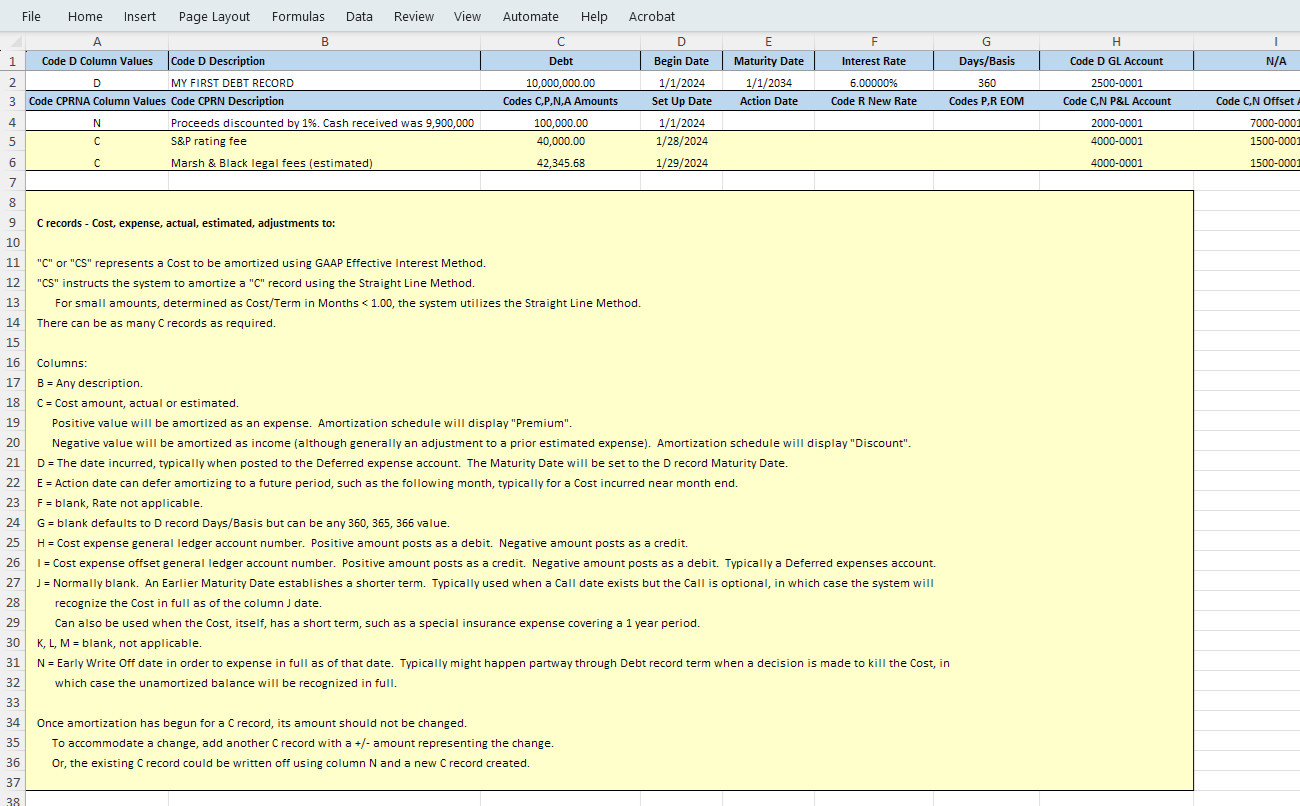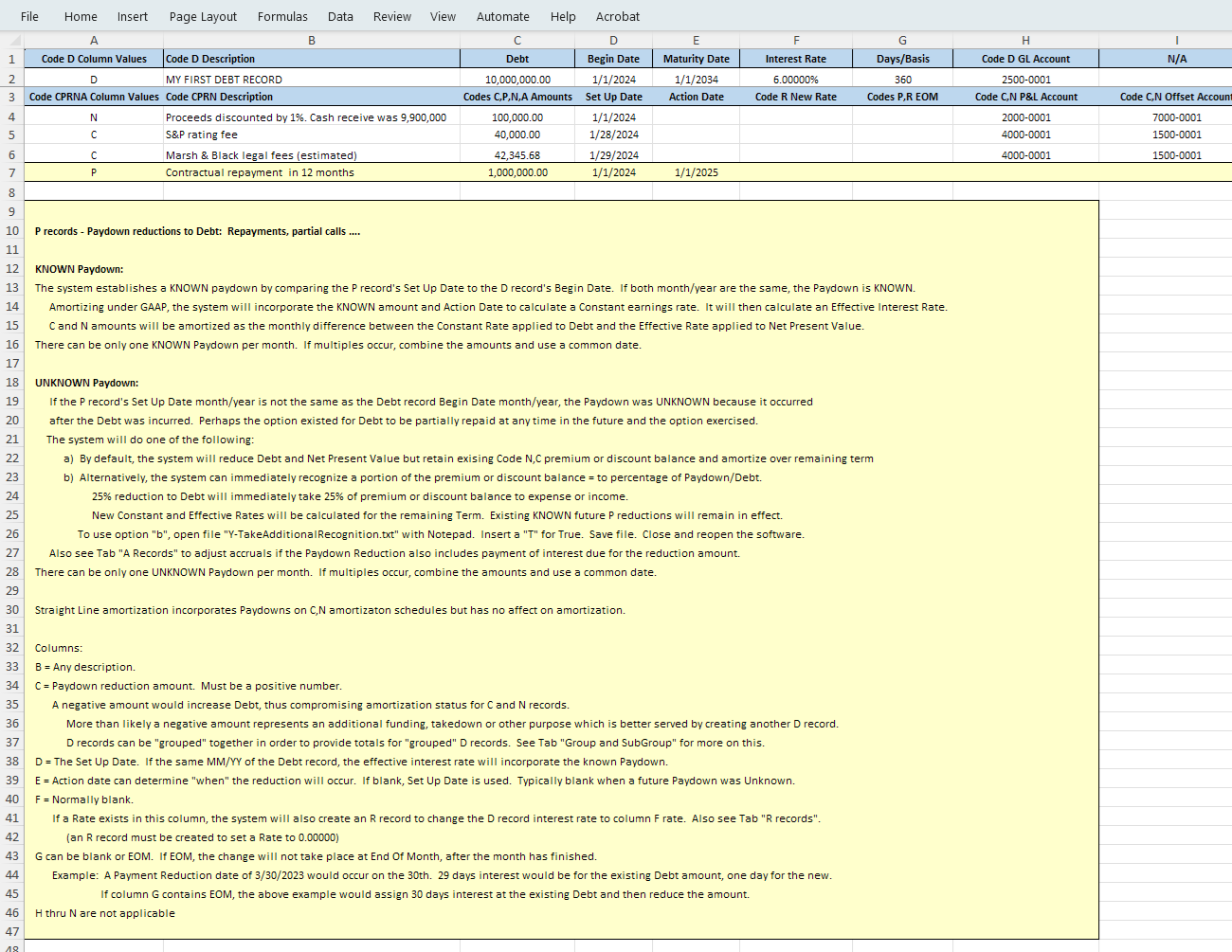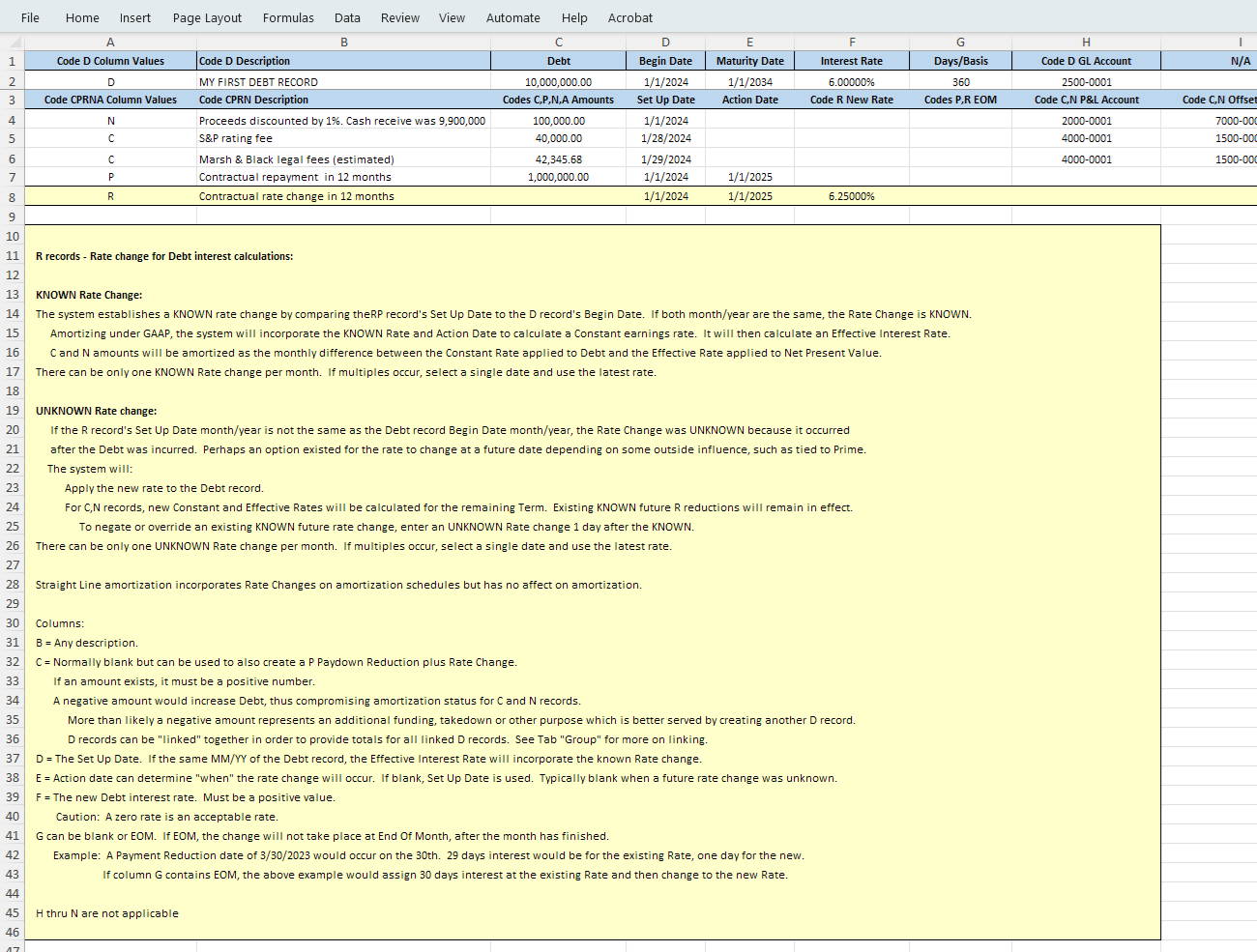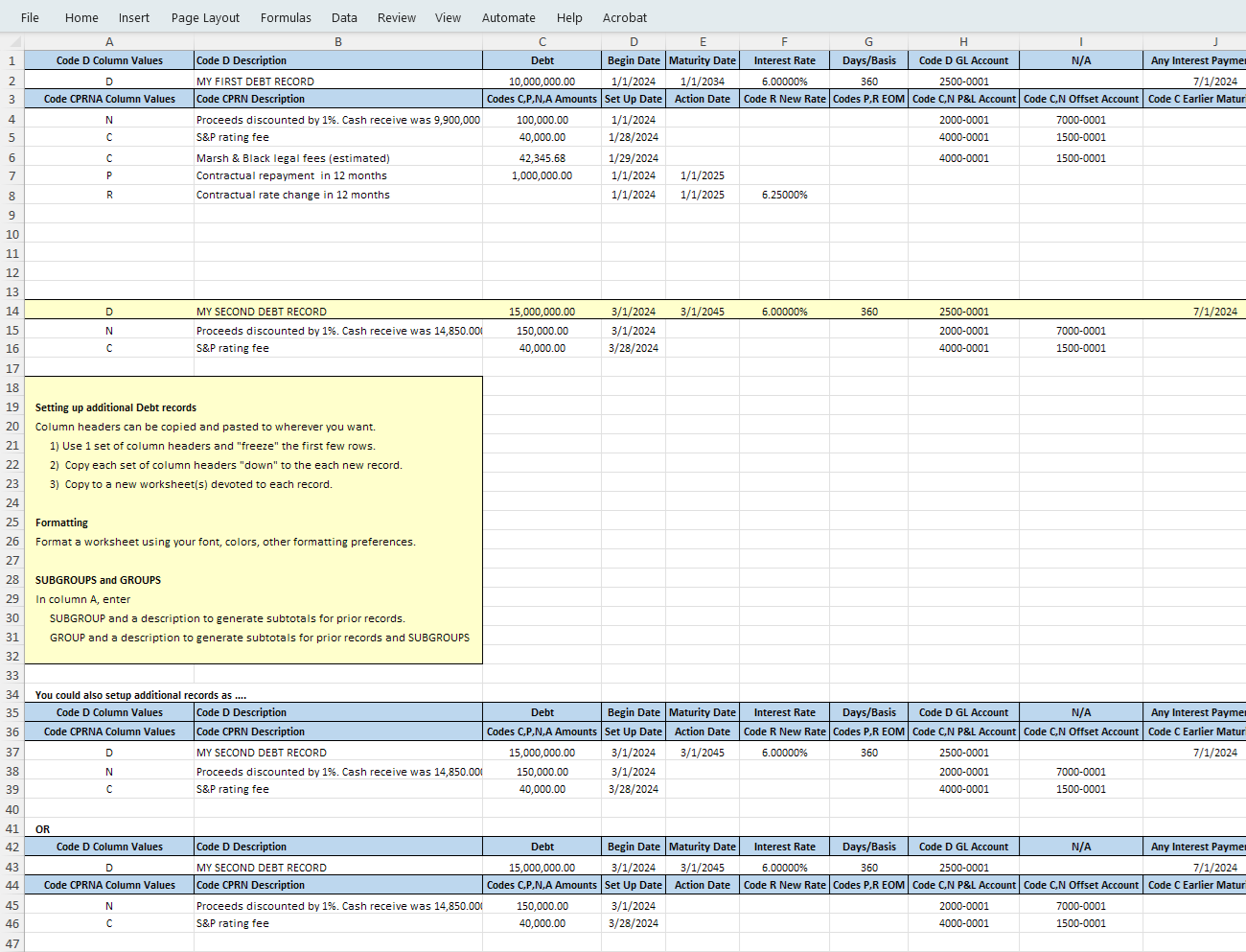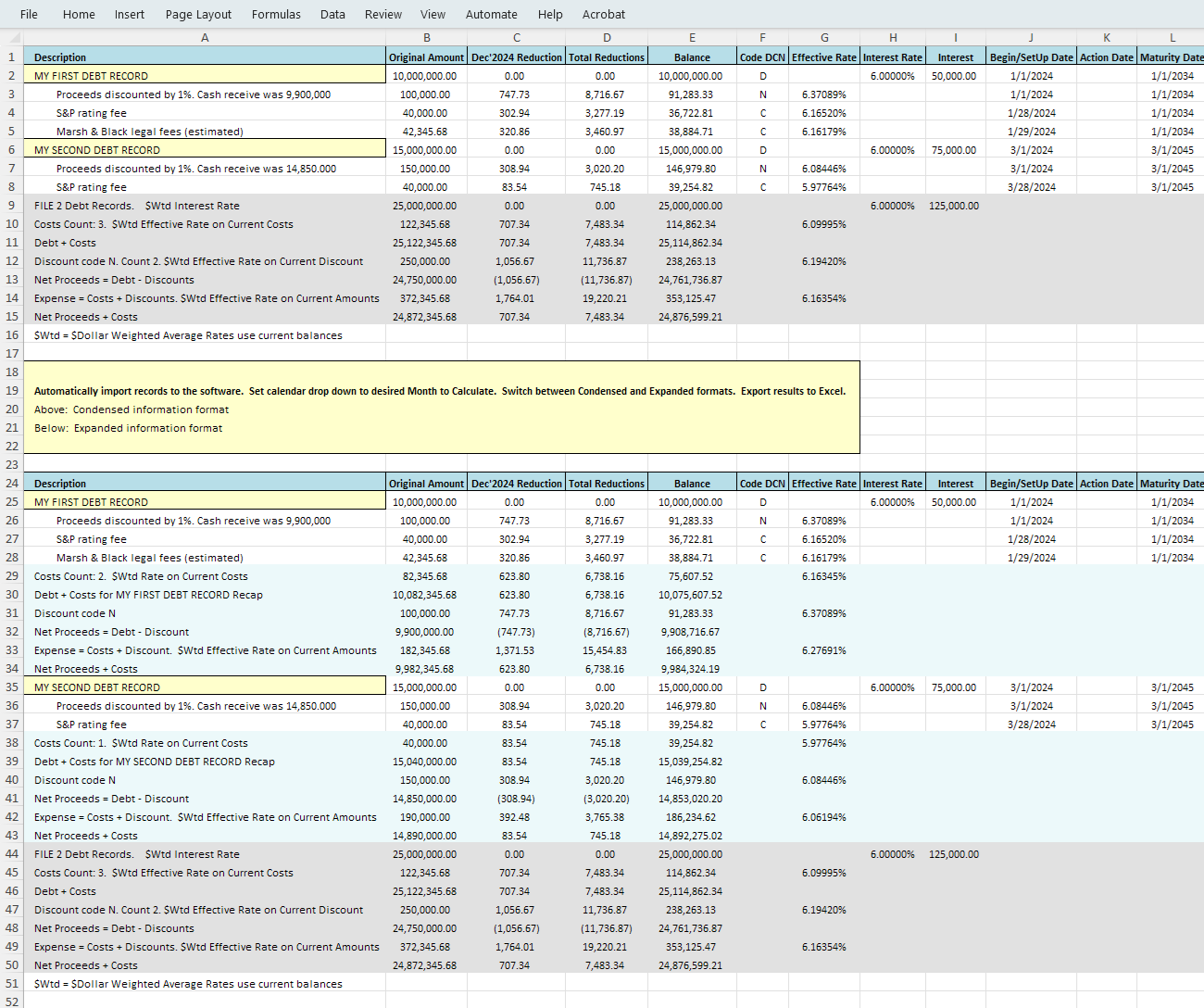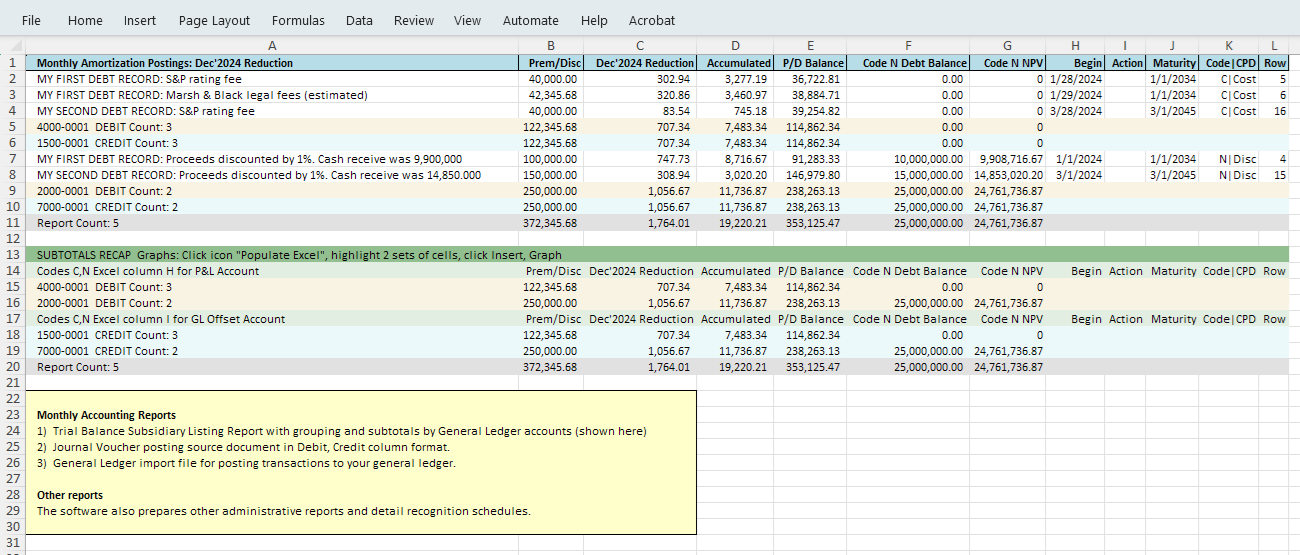Bond Issuers
Premium, Discount and Issue Costs Accounting Software
Utilize GAAP effective interestmethod or Straight Line method at the
file, debt record or individual cost, premium, discount
level
Scheduled and non-scheduled partial calls/redemptions/repayments, refinances and/or
rate changes
REPORTS LISTING
1) Monthly Posting: Costs,
Premiums, Discounts Amortization
Report. Followed with Journal
Voucher then General Ledger
Posting file.
Column A codes C & N: Costs plus
Premium amortization and
discount accretion recognized
for the selected calendar
calculation month. Records will
be sorted by the values in
spreadsheet column "H P&L
Accounts" within "column I
Offset Account". Totals will be
provided for each account.
A Journal Voucher and General
Ledger posting file will also be
created.
This report can also provide
Costs, Premium and Discount
totals by general ledger
accounts at any time.
(after the report is produced,
click "Escape" to cancel Journal
Voucher processing).
2) Monthly Posting: Accrued
Interest Report. Followed with
Journal Voucher then General
Ledger Posting file.
Column A code D: Requires values
in Debt columns J Payment Due
Date and K Payment Frequency.
The system determines the amount
of Debt interest to accrue for
the selected dropdown Calendar
month. Also provides "Total
Accrued" for balancing to
payable accounts.
Records will be sorted by the
Debt record values in column L
Interest Accrual P&L Account and
column M Interest Accrual Offset
Account. Totals will be provided
for each account. A Journal
Voucher and General Ledger
posting file will also be
created.
The report consists of records
with a Begin Date equal to or
earlier than the dropdown
Calendar month. Records which
have finalized in or prior to
the Calendar month will be
excluded.
The Accrued Interest report and
Accrued Interest Reversal report
(below) eliminate the need to
reconcile Interest Payable
accounts each month. Simply post
cash interest payments to an
expense account. The system will
"undo" previous accruals in an
Interest payment month.
3) Monthly Posting: Accrued
Interest Reversal Report.
Followed with Journal Voucher
then General Ledger Posting
file.
Column A code D: Requires values
in Debt columns J Payment Due
Date and K Payment Frequency.
The system determines the amount
of accrued interest to reverse
for records with an Interest
Payment date during the selected
dropdown Calendar month.
Subtotals are provided based on
values in spreadsheet column T.
Reversal amounts consist of
accrued interest previously
posted by the system for ALL
prior months (since the prior
Interest payment month).
The system calculates running
accrual for Debt through the
preceding month to determine the
amount to reverse (do not delete
a Debt record from the
spreadsheet until after running
this report).
Records will be sorted by the
Debt record values in
spreadsheet column L Interest
Accrual P&L Account and column M
Interest Accrual Offset Account.
Totals will be provided for each
account. A Journal Voucher and
General Ledger posting file will
also be created.
The report consists of Debt
records with a Begin Date equal
to or earlier than the calendar
month. Records which have
finalized, such as matured, in
months PRIOR to the calendar
month will be excluded.
4) Debt Balancing Report. Book
Value and NPV Balances.
Subtotals by Debt column H
account OR "N" records Offset
account column I.
Codes D and N: Subtotals within
Debt column H general ledger
account or "N" code Premium and
Discount records column I.
Original and current balances
for Debt, Premium and Discount
balances and NPV Book Values.
This report is typically used to
balance Book Values when
Premiums and Discounts are
involved.
Set dropdown Calendar date to
any month. Set Months to
Calculate to a value of 1
through 60 months to obtain
future projection results.
5) Summary Report: Debt with
Costs.
Column A codes D and C: Original
and current balances for Debt
plus all Costs. Subtotals for
each Debt record.
Option to run as "Cost Totals
only" which combines Costs on a
single line for each Debt
record.
If Costs exist, separate rows
for Debt and total Costs amounts
will be provided.
Note: Code N Premium and
Discount records are excluded
from this report.
Set dropdown Calendar date to
any month. Set Months to
Calculate to a value of 1
through 60 months to obtain
future projection results.
6) Summary Report: Debt with
Costs, Discounts, Premiums, Net
Proceeds.
Column A codes D, N and C:
Original and current balances
for Debt, premiums, discount and
all Costs. Subtotals for each
Debt record.
If Costs, Premiums or Discounts
exist, separate rows for Debt
and those total amounts will be
provided.
If Premiums or Discounts
involved, also provides Costs
related to Net Proceeds (cash
received).
Set dropdown Calendar date to
any month. Set Months to
Calculate to a value of 1
through 60 months to obtain
future projection results.
7) Cash Outflow Projection
Report: Interest payments plus
Debt reductions for the
reporting period.
Cash Outflow Projection for
interest payable, interim Debt
and maturing reductions and
remaining Debt balance at end
period.
Set dropdown Calendar month to
Beginning month. Set "Number of
Months" to calculate from 1 to
60 months.
Records having a zero Debt
balance at beginning of period
will be excluded.
8) Matured Records Report
showing Debt record balances
that dropped to zero during the
reporting period.
Debt records which matured or
otherwise paid off during the
reporting period.
Similar to "Cash Outflow
Projection report" but includes
only records where Debt dropped
to zero within the period.
9) Interest Payable Report for
Debt records having an interest
payment due this month.
Debt records having an interest
payment this month.
Similar to "Accrued Interest
Report" but includes only
records having an interest
payment due.
There are no general ledger
postings involved.
Options
for existing records
Option 1
The software can calculate
records using original
information.
Amortize
costs, premiums and discounts from original dates.
Book any variances from
software results to your
existing balances.
Option 2
Preserve current
balances.
Begin amortizing from an
"as of" date using current
balances.
|


